
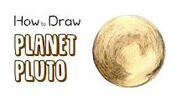
Pluto orbits the sun. Pluto was the smallest planet up until 2006, it is only a little smaller than Mercury. Pluto was a planet until 2006. The reason was because scientists came up with rules to be a planet. These are listed below.
- it orbits around the sun
- has the mass to consume hydrostatic equilibrium
- it has cleaned up most of its neighborhood
Pluto followed 2 of these rules, but has not cleaned up most of its neighborhood.
Pluto was discovered in 1930 by Clyde Tombaugh. Pluto was named after the Roman God of the Underworld. Clyde Tombaugh is probably the reason why the heart shape on the planet is called the Tombaugh Regio.
Like other members of the Kuiper belt, Pluto is composed primarily of rock and ice and is relatively small: approximately a sixth the mass of the Earth's Moon and a third its volume. It has an eccentric and highly inclined orbit that takes it from 30 to 49 AU (4.4–7.4 billion km) from the Sun. This causes Pluto to periodically come closer to the Sun than Neptune. As of 2011, it is 32.1 AU from the Sun.[1] From its discovery in 1930 until 2006, Pluto was classified as a planet. In the late 1970s, following the discovery of minor planet 2060 Chiron in the outer Solar System and the recognition of Pluto's relatively low mass, its status as a major planet began to be questioned.[2] In the late 20th and early 21st century, many objects similar to Pluto were discovered in the outer Solar System, notably the scattered disc object Eris in 2005, which is 27% more massive than Pluto.[3] On August 24, 2006, the International Astronomical Union (IAU) defined what it means to be a "planet" within the Solar System. This definition excluded Pluto as a planet and added it as a member of the new category "dwarf planet" along with Eris and Ceres.[4] After the reclassification, Pluto was added to the list of minor planets and given the number 134340.[5][6] In 2017 some scientists say Pluto is a planet, and It's Not A dwarf planet In 2019 Almost All Scientist Say Pluto Is A Planet.[7][8] by Summer 2023 The IAU Will Revert Pluto To A Major Planet Completely Along With Eris.
Pluto has four known moons, the largest being Charon discovered in 1978, along with Nix and Hydra, discovered in 2005,[9] and the provisionally named S/2011 P 1, discovered in 2011.[10] Pluto and Charon are sometimes described as a binary system because the barycenter of their orbits does not lie within either body.[11] However, the IAU has yet to formalize a definition for binary dwarf planets, and as such Charon is officially classified as a moon of Pluto.[12]
Discovery[]
- Main article: Planets beyond Neptune
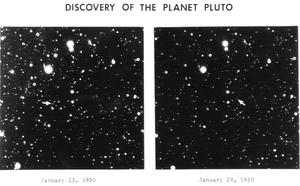
Discovery photographs of Pluto
In the 1840s, using Newtonian mechanics, Urbain Le Verrier predicted the position of the then-undiscovered planet Neptune after analyzing perturbations in the orbit of Uranus.Template:Sfn Subsequent observations of Neptune in the late 19th century caused astronomers to speculate that Uranus' orbit was being disturbed by another planet besides Neptune. In 1906, Percival Lowell, a wealthy Bostonian who had founded the Lowell Observatory in Flagstaff, Arizona in 1894, started an extensive project in search of a possible ninth planet, which he termed "Planet X".[13] By 1909, Lowell and William H. Pickering had suggested several possible celestial coordinates for such a planet.[14] Lowell and his observatory conducted his search until his death in 1916, but to no avail. Unknown to Lowell, on March 19, 1915, his observatory had captured two faint images of Pluto, but did not recognize them for what they were.[14][15] Lowell was not the first to unknowingly photograph Pluto. There are sixteen known pre-discoveries, with the oldest being made by the Yerkes Observatory on August 20, 1909.[16]
Due to a ten-year legal battle with Constance Lowell, Percival's widow, who attempted to wrest the observatory's million-dollar portion of his legacy for herself, the search for Planet X did not resume until 1929,Template:Sfn when its director, Vesto Melvin Slipher, summarily handed the job of locating Planet X to Clyde Tombaugh, a 23-year-old Kansan who had just arrived at the Lowell Observatory after Slipher had been impressed by a sample of his astronomical drawings.Template:Sfn
Tombaugh's task was to systematically image the night sky in pairs of photographs taken two weeks apart, then examine each pair and determine whether any objects had shifted position. Using a machine called a blink comparator, he rapidly shifted back and forth between views of each of the plates to create the illusion of movement of any objects that had changed position or appearance between photographs. On February 18, 1930, after nearly a year of searching, Tombaugh discovered a possible moving object on photographic plates taken on January 23 and January 29 of that year. A lesser-quality photograph taken on January 21 helped confirm the movement.Template:Sfn After the observatory obtained further confirmatory photographs, news of the discovery was telegraphed to the Harvard College Observatory on March 13, 1930.[14]
Name[]

Venetia Burney
The discovery made headlines across the globe. The Lowell Observatory, which had the right to name the new object, received over 1,000 suggestions from all over the world, ranging from Atlas to Zymal.[17] Tombaugh urged Slipher to suggest a name for the new object quickly before someone else did.[17] Constance Lowell proposed Zeus, then Percival and finally Constance. These suggestions were disregarded.[18]
The name Pluto was proposed by Venetia Burney (1918–2009), an eleven-year-old schoolgirl in Oxford, England.[19] Venetia was interested in classical mythology as well as astronomy, and considered the name, a name for the god of the underworld, appropriate for such a presumably dark and cold world. She suggested it in a conversation with her grandfather Falconer Madan, a former librarian at the University of Oxford's Bodleian Library. Madan passed the name to Professor Herbert Hall Turner, who then cabled it to colleagues in the United States.[20]
The object was officially named on March 24, 1930.[21][22] Each member of the Lowell Observatory was allowed to vote on a short-list of three: Minerva (which was already the name for an asteroid), Cronus (which had lost reputation through being proposed by the unpopular astronomer Thomas Jefferson Jackson See), and Pluto. Pluto received every vote.Template:Sfn The name was announced on May 1, 1930.[19] Upon the announcement, Madan gave Venetia five pounds (£5) (£Template:Inflation as of 2024),Template:Inflation-fn as a reward.[19]
It has been noted that the first two letters of Pluto are the initials of Percival Lowell, and Pluto's astronomical symbol (♇) is a monogram constructed from the letters 'PL'.[23] Pluto's astrological symbol resembles that of Neptune (File:Neptune symbol.svg), but has a circle in place of the middle prong of the trident (File:Pluto's astrological symbol.svg).
The name was soon embraced by wider culture. In 1930, Walt Disney introduced for Mickey Mouse a canine companion, named Pluto apparently in the object's honour, although Disney animator Ben Sharpsteen could not confirm why the name was given.[24] In 1941, Glenn T. Seaborg named the newly created element plutonium after Pluto, in keeping with the tradition of naming elements after newly discovered planets, following uranium, which was named after Uranus, and neptunium, which was named after Neptune.[25]
In Chinese, Japanese and Korean the name was translated as underworld king star (冥王星),[26][27] as suggested by Houei Nojiri in 1930.[28] Many other non-European languages use a transliteration of "Pluto" as their name for the object; some Indian languages use a form of Yama, the Guardian of Hell in Hindu mythology, such as the Gujarati Yamdev.[26]
Demise of Planet X[]
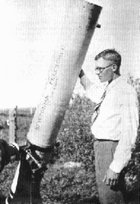
Clyde W. Tombaugh, the discoverer of Pluto
| Year | Mass | Notes |
|---|---|---|
| 1931 | 1 Earth | Nicholson & Mayall[29][30][31] |
| 1948 | 0.1 (1/10) Earth | Kuiper[32] |
| 1976 | 0.01 (1/100) Earth | Cruikshank, Pilcher, & MorrisonTemplate:Sfn |
| 1978 | 0.002 (1/500) Earth | Christy & Harrington[33] |
Once found, Pluto's faintness and lack of a resolvable disc cast doubt on the idea that it was Lowell's Planet X. Estimates of Pluto's mass were revised downward throughout the 20th century. In 1978, the discovery of Pluto's moon Charon allowed the measurement of Pluto's mass for the first time. Its mass, roughly 0.2% that of the Earth, was far too small to account for the discrepancies in the orbit of Uranus. Subsequent searches for an alternate Planet X, notably by Robert Sutton Harrington,[34] failed. In 1992, Myles Standish used data from Voyager 2's 1989 flyby of Neptune, which had revised the planet's total mass downward by 0.5%, to recalculate its gravitational effect on Uranus. With the new figures added in, the discrepancies, and with them the need for a Planet X, vanished.[35] Today, the majority of scientists agree that Planet X, as Lowell defined it, does not exist.[36] Lowell had made a prediction of Planet X's position in 1915 that was fairly close to Pluto's position at that time; Ernest W. Brown concluded almost immediately that this was a coincidence,[37] a view still held today.[35]
Orbit and rotation[]
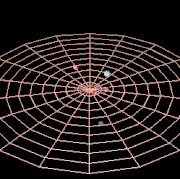
Pluto's orbit and the ecliptic.
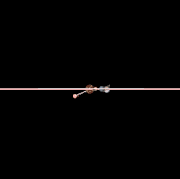
Orbit of Pluto—ecliptic view. This 'side view' of Pluto's orbit (in red) shows its large inclination to Earth's ecliptic orbital plane.

This diagram shows the relative positions of Pluto (red) and Neptune (blue) on selected dates. The size of Neptune and Pluto is depicted as inversely proportional to the distance between them to emphasise the closest approach in 1896.
Pluto's orbital period is 248 Earth years. Its orbital characteristics are substantially different from those of the planets, which follow nearly circular orbits around the Sun close to a flat reference plane called the ecliptic. In contrast, Pluto's orbit is highly inclined relative to the ecliptic (over 17°) and highly eccentric (elliptical). This high eccentricity means a small region of Pluto's orbit lies nearer the Sun than Neptune's. The Pluto–Charon barycentre came to perihelion on September 5, 1989,[38][lower-alpha 1] and was last closer to the Sun than Neptune between February 7, 1979 and February 11, 1999.[39]
In the long term Pluto's orbit is in fact chaotic. While computer simulations can be used to predict its position for several million years (both forward and backward in time), after intervals longer than the Lyapunov time of 10–20 million years, calculations become speculative: Pluto's tiny size makes it sensitive to unmeasurably small details of the Solar System, hard-to-predict factors that will gradually disrupt its orbit.[40][41] Millions of years from now, Pluto may well be at aphelion, at perihelion or anywhere in between, with no way for us to predict which. This does not mean Pluto's orbit itself is unstable, but its position on that orbit is impossible to determine so far ahead. Several resonances and other dynamical effects keep Pluto's orbit stable, safe from planetary collision or scattering.
Relationship with Neptune[]

Orbit of Pluto—polar view. This 'view from above' shows how Pluto's orbit (in red) is less circular than Neptune's (in blue), and how Pluto is sometimes closer to the Sun than Neptune. The darker halves of both orbits show where they pass below the plane of the ecliptic.
Despite Pluto's orbit appearing to cross that of Neptune when viewed from directly above, the two objects' orbits are aligned so that they can never collide or even approach closely. There are several reasons why.
At the simplest level, one can examine the two orbits and see that they do not intersect. When Pluto is closest to the Sun, and hence closest to Neptune's orbit as viewed from above, it is also the farthest above Neptune's path. Pluto's orbit passes about 8 AU above that of Neptune, preventing a collision.[42][43][44] Pluto's ascending and descending nodes, the points at which its orbit crosses the ecliptic, are currently separated from Neptune's by over 21°.[45]
This alone is not enough to protect Pluto; perturbations from the planets (especially Neptune) could alter aspects of Pluto's orbit (such as its orbital precession) over millions of years so that a collision could be possible. Some other mechanism or mechanisms must therefore be at work. The most significant of these is that Pluto lies in the 3:2 mean motion resonance with Neptune: for every three of Neptune's orbits around the Sun, Pluto makes two. The two objects then return to their initial positions and the cycle repeats, each cycle lasting about 500 years. This pattern is configured so that, in each 500-year cycle, the first time Pluto is near perihelion Neptune is over 50° behind Pluto. By Pluto's second perihelion, Neptune will have completed a further one and a half of its own orbits, and so will be a similar distance ahead of Pluto. Pluto and Neptune's minimum separation is over 17 AU. Pluto comes closer to Uranus (11 AU) than it does to Neptune.[44]
The 3:2 resonance between the two bodies is highly stable, and is preserved over millions of years.[46] This prevents their orbits from changing relative to one another; the cycle always repeats in the same way, and so the two bodies can never pass near to each other. Thus, even if Pluto's orbit were not highly inclined the two bodies could never collide.[44]
Other factors[]
Numerical studies have shown that over periods of millions of years, the general nature of the alignment between Pluto and Neptune's orbits does not change.[42][47] There are several other resonances and interactions that govern the details of their relative motion, and enhance Pluto's stability. These arise principally from two additional mechanisms (besides the 3:2 mean motion resonance).
First, Pluto's argument of perihelion, the angle between the point where it crosses the ecliptic and the point where it is closest to the Sun, librates around 90°.[47] This means that when Pluto is nearest the Sun, it is at its farthest above the plane of the Solar System, preventing encounters with Neptune. This is a direct consequence of the Kozai mechanism,[42] which relates the eccentricity of an orbit to its inclination to a larger perturbing body—in this case Neptune. Relative to Neptune, the amplitude of libration is 38°, and so the angular separation of Pluto's perihelion to the orbit of Neptune is always greater than 52° (= 90°–38°). The closest such angular separation occurs every 10,000 years.[46]
Second, the longitudes of ascending nodes of the two bodies—the points where they cross the ecliptic—are in near-resonance with the above libration. When the two longitudes are the same—that is, when one could draw a straight line through both nodes and the Sun—Pluto's perihelion lies exactly at 90°, and it comes closest to the Sun at its peak above Neptune's orbit. In other words, when Pluto most closely intersects the plane of Neptune's orbit, it must be at its farthest beyond it. This is known as the 1:1 superresonance, and is controlled by all the Jovian planets.[42]
To understand the nature of the libration, imagine a polar point of view, looking down on the ecliptic from a distant vantage point where the planets orbit counter-clockwise. After passing the ascending node, Pluto is interior to Neptune's orbit and moving faster, approaching Neptune from behind. The strong gravitational pull between the two causes angular momentum to be transferred to Pluto, at Neptune's expense. This moves Pluto into a slightly larger orbit, where it travels slightly slower, according to Kepler's third law. As its orbit changes, this has the gradual effect of changing the pericentre and longitudes of Pluto (and, to a lesser degree, of Neptune). After many such repetitions, Pluto is sufficiently slowed, and Neptune sufficiently speeded up, that Neptune begins to catch Pluto at the opposite side of its orbit (near the opposing node to where we began). The process is then reversed, and Pluto loses angular momentum to Neptune, until Pluto is sufficiently speeded up that it begins to catch Neptune again at the original node. The whole process takes about 20,000 years to complete.[44][46]
Rotation[]
Pluto's rotation period, its day, is equal to 6.39 Earth days.[48] Like Uranus, Pluto rotates on its "side" on its orbital plane, with an axial tilt of 120°, and so its seasonal variation is extreme; at its solstices, one-fourth of its surface is in permanent daylight, while another fourth is in permanent darkness.[49]
Physical characteristics[]

Hubble map of Pluto's surface, showing great variations in color and albedo
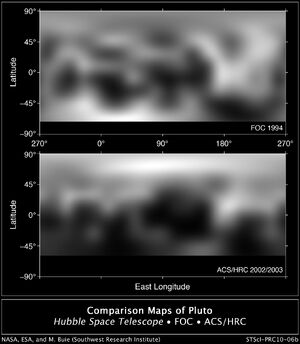

Three views of Pluto from different orientations
Pluto's distance from Earth makes in-depth investigation difficult. Many details about Pluto will remain unknown until 2015, when the New Horizons spacecraft is expected to arrive there.[50]
Appearance and surface[]
Pluto's visual apparent magnitude averages 15.1, brightening to 13.65 at perihelion.[51] To see it, a telescope is required; around 30 cm (12 in) aperture being desirable.[52] It looks star-like and without a visible disk even in large telescopes, because its angular diameter is only 0.11".
The earliest maps of Pluto, made in the late 1980s, were brightness maps created from close observations of eclipses by its largest moon, Charon. Observations were made of the change in the total average brightness of the Pluto–Charon system during the eclipses. For example, eclipsing a bright spot on Pluto makes a bigger total brightness change than eclipsing a dark spot. Computer processing of many such observations can be used to create a brightness map. This method can also track changes in brightness over time.[53][54]
Current maps have been produced from images from the Hubble Space Telescope (HST), which offers the highest resolution currently available, and show considerably more detail,[55] resolving variations several hundred kilometres across, including polar regions and large bright spots.[56] The maps are produced by complex computer processing, which find the best-fit projected maps for the few pixels of the Hubble images.[57] The two cameras on the HST used for these maps are no longer in service, so these will likely remain the most detailed maps of Pluto until the 2015 flyby of New Horizons.[57]
These maps, together with Pluto's lightcurve and the periodic variations in its infrared spectra, reveal that Pluto's surface is remarkably varied, with large changes in both brightness and colour.[58] Pluto is one of the most contrastive bodies in the Solar System, with as much contrast as Saturn's moon Iapetus.[55] The colour varies between charcoal black, dark orange and white:[59] Buie et al. term it "significantly less red than Mars and much more similar to the hues seen on Io with a slightly more orange cast".[56]
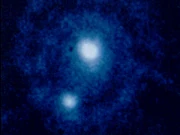
1990 photograph of Pluto and Charon. Taken by the Hubble Telescope.
Pluto's surface has changed between 1994 and 2002-3: the northern polar region has brightened and the southern hemisphere darkened.[59] Pluto's overall redness has also increased substantially between 2000 and 2002.[59] These rapid changes are probably related to seasonal condensation and sublimation of portions of Pluto's atmosphere, amplified by Pluto's extreme axial tilt and high orbital eccentricity.[59]
Spectroscopic analysis of Pluto's surface reveals it to be composed of more than 98 percent nitrogen ice, with traces of methane and carbon monoxide.[60] The face of Pluto oriented toward Charon contains more methane ice, while the opposite face contains more nitrogen and carbon monoxide ice.[61]
Structure[]

Theoretical structure of Pluto (2006)[62]
1. Frozen nitrogen[60]
2. Water ice
3. Rock
Observations by the Hubble Space Telescope place Pluto's density at between 1.8 and 2.1 g/cm3, suggesting its internal composition consists of roughly 50–70 percent rock and 30–50 percent ice by mass.[63] Because decay of radioactive minerals would eventually heat the ices enough for the rock to separate from them, scientists expect that Pluto's internal structure is differentiated, with the rocky material having settled into a dense core surrounded by a mantle of ice. The diameter of the core should be around 1,700 km, 70% of Pluto's diameter.[62] It is possible that such heating continues today, creating a subsurface ocean layer of liquid water some 100 to 180 km thick at the core–mantle boundary.[62][64] The DLR Institute of Planetary Research calculated that Pluto's density-to-radius ratio lies in a transition zone, along with Neptune's moon Triton, between icy satellites like the mid-sized moons of Uranus and Saturn, and rocky satellites such as Jupiter's Europa.[65]
Mass and size[]

Pluto's volume is about 0.6% that of Earth
Pluto's mass is 1.31×1022 kg, less than 0.24 percent that of the Earth,[66] while its diameter is 2,306 (+/- 20) km, or roughly 66% that of the Moon.[67] Pluto's atmosphere complicates determining its true solid size within a certain margin.[68]
Astronomers, assuming Pluto to be Lowell's Planet X, initially calculated its mass based on its presumed effect on Neptune and Uranus. In 1955 Pluto was calculated to be roughly the mass of the Earth, with further calculations in 1971 bringing the mass down to roughly that of Mars.Template:Sfn In 1976, Dale Cruikshank, Carl Pilcher and David Morrison of the University of Hawaii calculated Pluto's albedo for the first time, finding that it matched that for methane ice; this meant Pluto had to be exceptionally luminous for its size and therefore could not be more than 1 percent the mass of the Earth.Template:Sfn Pluto's albedo is 1.3–2.0 times greater than that of Earth.[51]
The discovery of Pluto's satellite Charon in 1978 enabled a determination of the mass of the Pluto–Charon system by application of Newton's formulation of Kepler's third law. Once Charon's gravitational effect was measured, Pluto's true mass could be determined. Observations of Pluto in occultation with Charon allowed scientists to establish Pluto's diameter more accurately, while the invention of adaptive optics allowed them to determine its shape more accurately.[69]
| Year | Radius (Diameter) | Notes |
|---|---|---|
| 1993 | 1195 (2390) km | Millis, et al.[70] (If no haze)[71] |
| 1993 | 1180 (2360) km | Millis, et al. (surface & haze)[71] |
| 1994 | 1164 (2328) km | Young & Binzel[72] |
| 2006 | 1153 (2306) km | Buie, et al.[67] |
| 2007 | 1161 (2322) km | Young, Young, & Buie[68] |
Among the objects of the Solar System, Pluto is much less massive than the terrestrial planets, and at less than 0.2 lunar masses, it is also less massive than seven moons: Ganymede, Titan, Callisto, Io, Earth's Moon, Europa and Triton. Pluto is more than twice the diameter and a dozen times the mass of the dwarf planet Ceres, the largest object in the asteroid belt. It is less massive than the dwarf planet Eris, a trans-Neptunian object discovered in 2005. Given the error bars in the different size estimates, it is currently unknown whether Eris or Pluto has the larger diameter.[71] Both Pluto and Eris are estimated to have solid-body diameters of about 2330 km.[71] Determinations of Pluto's size are complicated by its atmosphere, and possible hydrocarbon haze.[71]
Atmosphere[]

CRIRES model-based computer-generated impression of the Plutonian surface, with atmospheric haze, and Charon and the Sun in the sky.
Pluto's atmosphere consists of a thin envelope of nitrogen, methane, and carbon monoxide gases, which are derived from the ices of these substances on its surface.[73] Its surface pressure ranges from 6.5 to 24 μbar.[74] Pluto's elongated orbit is predicted to have a major effect on its atmosphere: as Pluto moves away from the Sun, its atmosphere should gradually freeze out, and fall to the ground. When Pluto is closer to the Sun, the temperature of Pluto's solid surface increases, causing the ices to sublimate into gas. This creates an anti-greenhouse effect; much as sweat cools the body as it evaporates from the surface of the skin, this sublimation cools the surface of Pluto. Scientists using the Submillimeter Array have recently discovered that Pluto's temperature is about 69, 10 K colder than would otherwise be expected.[75]
The presence of methane, a powerful greenhouse gas, in Pluto's atmosphere creates a temperature inversion, with average temperatures 36 K warmer 10 km above the surface.[76] The lower atmosphere contains a higher concentration of methane than its upper atmosphere.[76]
The first evidence of Pluto's atmosphere was first suggested by N. Brosch and H. Mendelson of the Wise Observatory in Israel in 1985,[77] and then definitively detected by the Kuiper Airborne Observatory in 1988, from observations of occultations of stars by Pluto.[78] When an object with no atmosphere moves in front of a star, the star abruptly disappears; in the case of Pluto, the star dimmed out gradually.[77] From the rate of dimming, the atmospheric pressure was determined to be 0.15 pascal, roughly 1/700,000 that of Earth.[79]
In 2002, another occultation of a star by Pluto was observed and analysed by teams led by Bruno Sicardy of the Paris Observatory,[80] James L. Elliot of MIT,[81] and Jay Pasachoff of Williams College.[82] Surprisingly, the atmospheric pressure was estimated to be 0.3 pascal, even though Pluto was farther from the Sun than in 1988 and thus should have been colder and had a more rarefied atmosphere. One explanation for the discrepancy is that in 1987 the south pole of Pluto came out of shadow for the first time in 120 years, causing extra nitrogen to sublimate from the polar cap. It will take decades for the excess nitrogen to condense out of the atmosphere as it freezes onto the north pole's now permanently dark ice cap.[83] Spikes in the data from the same study revealed what may be the first evidence of wind in Pluto's atmosphere.[83] Another stellar occultation was observed by the MIT-Williams College team of James Elliot, Jay Pasachoff, and a Southwest Research Institute team led by Leslie Young on June 12, 2006 from sites in Australia.[84]
In October 2006, Dale Cruikshank of NASA/Ames Research Center (a New Horizons co-investigator) and his colleagues announced the spectroscopic discovery of ethane on Pluto's surface. This ethane is produced from the photolysis or radiolysis (i.e., the chemical conversion driven by sunlight and charged particles) of frozen methane on Pluto's surface and suspended in its atmosphere.[85]
Satellites[]

Pluto and Charon as taken with the ESA/Dornier Faint Object Camera on Hubble Space Telescope in 1994
- Main article: Moons of Pluto
Pluto has four known natural satellites: Charon, first identified in 1978 by astronomer James Christy; Nix and Hydra, both discovered in 2005,[86] and S/2011 P 1 (provisional name, also known as P4), identified by the Hubble Space Telescope in 2011.[87]
The Plutonian moons are unusually close to Pluto, compared to other observed systems. Moons could potentially orbit Pluto up to 53% (or 69%, if retrograde) of the Hill sphere radius, the stable gravitational zone of Pluto's influence. For example, Psamathe orbits Neptune at 40% of the Hill radius. In the case of Pluto, only the inner 3% of the zone is known to be occupied by satellites. In the discoverers’ terms, the Plutonian system appears to be "highly compact and largely empty",[88] although others have pointed out the possibility of additional objects, including a small ring system.[89]
Charon[]
- Main article: Charon (moon)
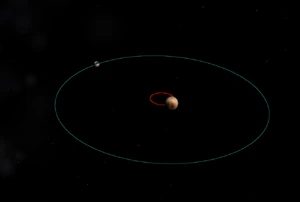
An oblique view of the Pluto–Charon system showing that Pluto orbits a point outside itself. Pluto's orbit is shown in red and Charon's orbit is shown in green.
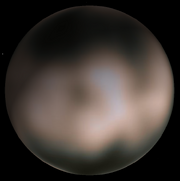
The surface of Charon
The Pluto–Charon system is noteworthy for being one of the Solar System's few binary systems, defined as those whose barycentre lies above the primary's surface (617 Patroclus is a smaller example, the Sun and Jupiter the only larger one).[90] This and the large size of Charon relative to Pluto has led some astronomers to call it a dwarf double planet.[91] The system is also unusual among planetary systems in that each is tidally locked to the other: Charon always presents the same face to Pluto, and Pluto always presents the same face to Charon: from any position on either body, the other is always at the same position in the sky, or always obscured.[92] Because of this, the rotation period of each is equal to the time it takes the entire system to rotate around its common centre of gravity.[48] Just as Pluto revolves on its side relative to the orbital plane, so the Pluto–Charon system does also.[49] In 2007, observations by the Gemini Observatory of patches of ammonia hydrates and water crystals on the surface of Charon suggested the presence of active cryo-geysers.[93]
Nix and Hydra[]
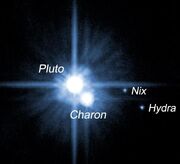
Plutonian system with imaging artifacts

Diagram of the Plutonian system.
- Main article: Nix (moon)
Two additional moons of Pluto were imaged by astronomers working with the Hubble Space Telescope on May 15, 2005, and received provisional designations of S/2005 P 1 and S/2005 P 2. The International Astronomical Union officially named Pluto's newest moons Nix (or Pluto II, the inner of the two moons, formerly P 2) and Hydra (Pluto III, the outer moon, formerly P 1), on June 21, 2006.[94]
These small moons orbit Pluto at approximately two and three times the distance of Charon: Nix at 48,700 kilometres and Hydra at 64,800 kilometres from the barycenter of the system. They have nearly circular prograde orbits in the same orbital plane as Charon.
Observations of Nix and Hydra to determine individual characteristics are ongoing. Hydra is sometimes brighter than Nix, suggesting either that it is larger or that different parts of its surface may vary in brightness. Sizes are estimated from albedos. If the moons' albedo is similar to Charon's at 35%, then their diameters can be estimated at 46 kilometres for Nix and 61 kilometres for the brighter Hydra. Upper limits on their diameters can be estimated by assuming the 4% albedo of the darkest Kuiper Belt objects; these bounds are 137 ± 11 km and 167 ± 10 km, respectively. At the larger end of this range, the inferred masses are less than 0.3% that of Charon, or 0.03% of Pluto's.[95]
The discovery of the two small moons suggests that Pluto may possess a variable ring system. Small body impacts can create debris that can form into planetary rings. Data from a deep optical survey by the Advanced Camera for Surveys on the Hubble Space Telescope suggest that no ring system is present. If such a system exists, it is either tenuous like the rings of Jupiter or is tightly confined to less than 1,000 km in width.[89]
Similar conclusions have been made from occultation studies.[96] In imaging the Plutonian system, observations from Hubble placed limits on any additional moons. With 90% confidence, no additional moons larger than 12 km (or a maximum of 37 km with an albedo of 0.041) exist beyond the glare of Pluto 5 arcseconds from the dwarf planet. This assumes a Charon-like albedo of 0.38; at a 50% confidence level the limit is 8 kilometres.[97]
S/2011 P 1[]
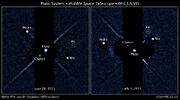
- Main article: S/2011 P 1
On July 20, 2011 Mark Showalter of the SETI Institute announced the discovery of a fourth moon of Pluto, provisionally named S/2011 P 1 or P4. It was noticed by NASA's Hubble Space Telescope during a survey searching for rings around the dwarf planet. It has an estimated diameter of 13 to 34 km and is located between the orbits of Nix and Hydra.[87]
S/2011 P 1 was first seen in a photo taken with Hubble's Wide Field Camera 3 on June 28. It was confirmed in subsequent Hubble pictures taken on July 3 and July 18.[87]
Near resonances[]
Nix and Hydra are very close to (but not in) 4:1 and 6:1 mean motion orbital resonances with Charon.[98] S/2011 P 1 fits neatly into this arrangement with a near 5:1 resonance with Charon.[citation needed] Determining how close any of these near integer orbital period ratios might actually be to a true resonance requires accurate knowledge of the satellites' precessions.
| Name (Pronunciation) |
Discovery Year |
Diameter (km) |
Mass (kg) |
Orbital radius (km) (barycentric) |
Orbital period (d) | |
|---|---|---|---|---|---|---|
| Pluto | /ˈpluːtoʊ/ | 1930 | 2,306 (66% Moon) |
13,050 ×1018 (18% Moon) |
2,040 (0.6% Moon) |
|
| Charon | /ˈʃærən/, /ˈkɛərən/ |
1978 | 1,205 (35% Moon) |
1,520 ×1018 (2% Moon) |
17,530 (5% Moon) |
6.3872 (25% Moon) |
| Nix | /ˈnɪks/ | 2005 | 91 | 4 ×1017 | 48,708 | 24.856 |
| S/2011 P 1 | 2011 | 13–34 | ~59,000 | 32.1 | ||
| Hydra | /ˈhaɪdrə/ | 2005 | 114 | 8 ×1017 | 64,749 | 38.206 |
Mass of Nix and Hydra assumes icy/porous density of 1.0 g/cm3
Origins[]
- Main article: Kuiper belt
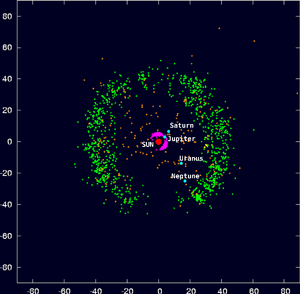
Plot of known Kuiper belt objects, set against the four gas giants.
Pluto's origin and identity had long puzzled astronomers. One early hypothesis was that Pluto was an escaped moon of Neptune, knocked out of orbit by its largest current moon, Triton. This notion has been heavily criticised because Pluto never comes near Neptune in its orbit.[100]
Pluto's true place in the Solar System began to reveal itself only in 1992, when astronomers began to find small icy objects beyond Neptune that were similar to Pluto not only in orbit but also in size and composition. This trans-Neptunian population is believed to be the source of many short-period comets. Astronomers now believe Pluto to be the largest[lower-alpha 2] member of the Kuiper belt, a somewhat stable ring of objects located between 30 and 50 AU from the Sun. Like other Kuiper-belt objects (KBOs), Pluto shares features with comets; for example, the solar wind is gradually blowing Pluto's surface into space, in the manner of a comet.[101] If Pluto were placed as near to the Sun as Earth, it would develop a tail, as comets do.[102]
Though Pluto is the largest of the Kuiper belt objects discovered so far, Neptune's moon Triton, which is slightly larger than Pluto, is similar to it both geologically and atmospherically, and is believed to be a captured Kuiper belt object.[103] Eris (see below) is also larger than Pluto but is not strictly considered a member of the Kuiper belt population. Rather, it is considered a member of a linked population called the scattered disc.
A large number of Kuiper belt objects, like Pluto, possess a 3:2 orbital resonance with Neptune. KBOs with this orbital resonance are called "plutinos", after Pluto.[104]
Like other members of the Kuiper belt, Pluto is thought to be a residual planetesimal; a component of the original protoplanetary disc around the Sun that failed to fully coalesce into a full-fledged planet. Most astronomers agree that Pluto owes its current position to a sudden migration undergone by Neptune early in the Solar System's formation. As Neptune migrated outward, it approached the objects in the proto-Kuiper belt, setting one in orbit around itself, which became its moon Triton, locking others into resonances and knocking others into chaotic orbits. The objects in the scattered disc, a dynamically unstable region overlapping the Kuiper belt, are believed to have been placed in their current positions by interactions with Neptune's migrating resonances.[105] A 2004 computer model by Alessandro Morbidelli of the Observatoire de la Côte d'Azur in Nice suggested that the migration of Neptune into the Kuiper belt may have been triggered by the formation of a 1:2 resonance between Jupiter and Saturn, which created a gravitational push that propelled both Uranus and Neptune into higher orbits and caused them to switch places, ultimately doubling Neptune's distance from the Sun. The resultant expulsion of objects from the proto-Kuiper belt could also explain the Late Heavy Bombardment 600 million years after the Solar System's formation and the origin of Jupiter's Trojan asteroids.[106] It is possible that Pluto had a near-circular orbit about 33 AU from the Sun before Neptune's migration perturbed it into a resonant capture.[107] The Nice model requires that there were about a thousand Pluto-sized bodies in the original planetesimal disk; these may have included the bodies which became Triton and Eris.[106]
Exploration[]
- Main article: New Horizons

New Horizons, launched on January 19, 2006
Pluto presents significant challenges for spacecraft because of its small mass and great distance from Earth. Voyager 1 could have visited Pluto, but controllers opted instead for a close flyby of Saturn's moon Titan, resulting in a trajectory incompatible with a Pluto flyby. Voyager 2 never had a plausible trajectory for reaching Pluto.[108] No serious attempt to explore Pluto by spacecraft occurred until the last decade of the 20th century. In August 1992, JPL scientist Robert Staehle telephoned Pluto's discoverer, Clyde Tombaugh, requesting permission to visit his planet. "I told him he was welcome to it," Tombaugh later remembered, "though he's got to go one long, cold trip."[109] Despite this early momentum, in 2000, NASA cancelled the Pluto Kuiper Express mission, citing increasing costs and launch vehicle delays.[110]
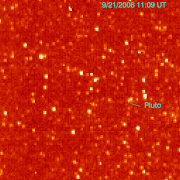
First Pluto sighting from New Horizons
After an intense political battle, a revised mission to Pluto, dubbed New Horizons, was granted funding from the US government in 2003.[111] New Horizons was launched successfully on January 19, 2006. The mission leader, S. Alan Stern, confirmed that some of the ashes of Clyde Tombaugh, who died in 1997, had been placed aboard the spacecraft.[112]
In early 2007 the craft made use of a gravity assist from Jupiter. Its closest approach to Pluto will be on July 14, 2015; scientific observations of Pluto will begin 5 months before closest approach and will continue for at least a month after the encounter. New Horizons captured its first (distant) images of Pluto in late September 2006, during a test of the Long Range Reconnaissance Imager (LORRI).[113] The images, taken from a distance of approximately 4.2 billion kilometres, confirm the spacecraft's ability to track distant targets, critical for maneuvering toward Pluto and other Kuiper Belt objects.
New Horizons will use a remote sensing package that includes imaging instruments and a radio science investigation tool, as well as spectroscopic and other experiments, to characterise the global geology and morphology of Pluto and its moon Charon, map their surface composition and analyse Pluto's neutral atmosphere and its escape rate. New Horizons will also photograph the surfaces of Pluto and Charon.
The discovery of Pluto's two small moons, Nix and Hydra, may present unforeseen challenges for the probe. Debris from collisions between Kuiper belt objects and the smaller moons, with their relatively low escape velocities, may produce a tenuous dusty ring. Were New Horizons to fly through such a ring system, there would be an increased potential for micrometeoroid damage that could disable the probe.[89]
Concepts[]
A Pluto orbiter/lander/sample return mission was proposed in 2003. The plan included a twelve-year trip from Earth to Pluto, mapping from orbit, multiple landings, a warm water probe, and possible in situ propellant production for another twelve-year trip back to Earth with samples. Power and propulsion would come from the bimodal MITEE nuclear reactor system.[114]
Classification[]
- Main article: Definition of planet
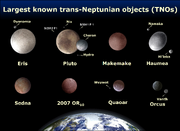
Artistic comparison of Eris, Pluto, Makemake, Haumea, Sedna, 2007 OR10, Quaoar, Orcus, and Earth. These eight trans-Neptunian objects have the brightest absolute magnitudes, although several other TNOs have been found to be physically larger than Orcus, and several more may yet be found.
After Pluto's place within the Kuiper belt was determined, its official status as a planet became controversial, with many questioning whether Pluto should be considered together with or separately from its surrounding population.
Museum and planetarium directors occasionally created controversy by omitting Pluto from planetary models of the Solar System. The Hayden Planetarium reopened after renovation in 2000 with a model of only eight planets. The controversy made headlines at the time.[115]
In 2002, the KBO 50000 Quaoar was discovered, with a diameter then thought to be roughly 1280 kilometres, about half that of Pluto.[116] In 2004, the discoverers of 90377 Sedna placed an upper limit of 1800 km on its diameter, nearer to Pluto's diameter of 2320 km,[117] although Sedna's diameter was revised downward to less than 1600 km by 2007.[118] Just as Ceres, Pallas, Juno and Vesta eventually lost their planet status after the discovery of many other asteroids, so, it was argued, Pluto should be reclassified as one of the Kuiper belt objects.
On July 29, 2005, the discovery of a new Trans-Neptunian object was announced. Named Eris, it is now known to be approximately the same size as Pluto.[71] This was the largest object discovered in the Solar System since Triton in 1846. Its discoverers and the press initially called it the tenth planet, although there was no official consensus at the time on whether to call it a planet.[119] Others in the astronomical community considered the discovery the strongest argument for reclassifying Pluto as a minor planet.[120]
2006: IAU classification[]
- Main article: IAU definition of planet
The debate came to a head in 2006 with an IAU resolution that created an official definition for the term "planet". According to this resolution, there are three main conditions for an object to be considered a 'planet':
- The object must be in orbit around the Sun.
- The object must be massive enough to be a sphere by its own gravitational force. More specifically, its own gravity should pull it into a shape of hydrostatic equilibrium.
- It must have cleared the neighbourhood around its orbit.[121][122]
Pluto fails to meet the third condition, since its mass is only 0.07 times that of the mass of the other objects in its orbit (Earth's mass, by contrast, is 1.7 million times the remaining mass in its own orbit).[120][122] The IAU further resolved that Pluto be classified in the simultaneously created dwarf planet category, and that it act as the prototype for the plutoid category of trans-Neptunian objects, in which it would be separately, but concurrently, classified.[123]
On September 13, 2006, the IAU included Pluto, Eris, and the Eridian moon Dysnomia in their Minor Planet Catalogue, giving them the official minor planet designations "(134340) Pluto", "(136199) Eris", and "(136199) Eris I Dysnomia".[124] If Pluto had been given a minor planet name upon its discovery, the number would have been about 1,164 rather than 134,340.
There has been some resistance within the astronomical community toward the reclassification.[125][126][127] Alan Stern, principal investigator with NASA's New Horizons mission to Pluto, has publicly derided the IAU resolution, stating that "the definition stinks, for technical reasons."[128] Stern's contention is that by the terms of the new definition Earth, Mars, Jupiter, and Neptune, all of which share their orbits with asteroids, would be excluded.[129] His other claim is that because less than five percent of astronomers voted for it, the decision was not representative of the entire astronomical community.[129] Marc W. Buie of the Lowell observatory has voiced his opinion on the new definition on his website and is one of the petitioners against the definition.[130] Others have supported the IAU. Mike Brown, the astronomer who discovered Eris, said "through this whole crazy circus-like procedure, somehow the right answer was stumbled on. It’s been a long time coming. Science is self-correcting eventually, even when strong emotions are involved."[131]
Researchers on both sides of the debate gathered on August 14–16, 2008, at The Johns Hopkins University Applied Physics Laboratory for a conference that included back-to-back talks on the current IAU definition of a planet.[132] Entitled "The Great Planet Debate",[133] the conference published a post-conference press release indicating that scientists could not come to a consensus about the definition of a planet.[134] Just before the conference, on June 11, 2008, the IAU announced in a press release that the term "plutoid" would henceforth be used to describe Pluto and other objects similar to Pluto which have an orbital semimajor axis greater than that of Neptune and enough mass to be of near-spherical shape.[123][135][136]
Reaction[]

A promotional event with a staged Pluto "protest". Members playing protesters of the reclassification of Pluto on the left, with those playing counter-protesters on the right
Reception to the IAU decision was mixed. While some accepted the reclassification, others seek to overturn the decision with online petitions urging the IAU to consider reinstatement. A resolution introduced by some members of the California State Assembly light-heartedly denounces the IAU for "scientific heresy", among other crimes.[137] The U.S. state of New Mexico's House of Representatives passed a resolution in honor of Tombaugh, a longtime resident of that state, which declared that Pluto will always be considered a planet while in New Mexican skies and that March 13, 2007 was Pluto Planet Day.[138][139] The Illinois State Senate passed a similar resolution in 2009, on the basis that Clyde Tombaugh, the discoverer of Pluto, was born in Illinois. The resolution asserted that Pluto was "unfairly downgraded to a 'dwarf' planet" by the IAU.[140]
Some members of the public have also rejected the change, citing the disagreement within the scientific community on the issue, or for sentimental reasons, maintaining that they have always known Pluto as a planet and will continue to do so regardless of the IAU decision.[141]
See also[]
- Dwarf planet
- Moons of Pluto
- Pluto in astrology
- Pluto in fiction
- Solar eclipses on Pluto
Notes[]
- ↑ Cite error: Invalid
<ref>tag; no text was provided for refs namedAstDyS-Pluto - ↑ Cite error: Invalid
<ref>tag; no text was provided for refs namedridpath - ↑ Cite error: Invalid
<ref>tag; no text was provided for refs namedhubblesite2007/24 - ↑ Cite error: Invalid
<ref>tag; no text was provided for refs namedBBC-Akwagyiram 2005-08-02 - ↑ Cite error: Invalid
<ref>tag; no text was provided for refs namedSpahr 2006-09-07 - ↑ Cite error: Invalid
<ref>tag; no text was provided for refs namedShiga 2006-09-07 - ↑ Cite error: Invalid
<ref>tag; no text was provided for refs namedGray 2008-08-10 - ↑ Adam Gorwyn, Alan Stern: ‘A Chihuahua is still a dog, and Pluto is still a planet’. EarthSky interview, 2010 Feb 18
- ↑ Cite error: Invalid
<ref>tag; no text was provided for refs namedSicardy2006 - ↑ Cite error: Invalid
<ref>tag; no text was provided for refs namedNasa-Hubble-Pluto moon - ↑ Cite error: Invalid
<ref>tag; no text was provided for refs namedOlkin_2003 - ↑ Cite error: Invalid
<ref>tag; no text was provided for refs namedIAU Pluto - ↑ Cite error: Invalid
<ref>tag; no text was provided for refs namedTombaugh1946 - ↑ 14.0 14.1 14.2 Cite error: Invalid
<ref>tag; no text was provided for refs namedHoyt - ↑ Cite error: Invalid
<ref>tag; no text was provided for refs namedLittman1990 - ↑ Cite error: Invalid
<ref>tag; no text was provided for refs namedBuchwaldDimarioWild2000 - ↑ 17.0 17.1 Cite error: Invalid
<ref>tag; no text was provided for refs namedpluto guide - ↑ Cite error: Invalid
<ref>tag; no text was provided for refs namedMager - ↑ 19.0 19.1 19.2 Cite error: Invalid
<ref>tag; no text was provided for refs namedVenetia - ↑ Cite error: Invalid
<ref>tag; no text was provided for refs namedClaxton1951 - ↑ Cite error: Invalid
<ref>tag; no text was provided for refs namedThe Times 27 May 1930 - ↑ Cite error: Invalid
<ref>tag; no text was provided for refs namedNYTimes 25 May 1930 - ↑ Cite error: Invalid
<ref>tag; no text was provided for refs namedJPL/NASA Pluto's Symbol - ↑ Cite error: Invalid
<ref>tag; no text was provided for refs namedHeinrichs2006 - ↑ Cite error: Invalid
<ref>tag; no text was provided for refs namedClarkHobart2000 - ↑ 26.0 26.1 Cite error: Invalid
<ref>tag; no text was provided for refs namednineplan - ↑ Cite error: Invalid
<ref>tag; no text was provided for refs namedBathrobe - ↑ Cite error: Invalid
<ref>tag; no text was provided for refs namedRenshawIhara2000 - ↑ Cite error: Invalid
<ref>tag; no text was provided for refs namedRAS1931.91 - ↑ Cite error: Invalid
<ref>tag; no text was provided for refs namedNicholson et al 1930 - ↑ Cite error: Invalid
<ref>tag; no text was provided for refs namedNicholson et al 1931 - ↑ Cite error: Invalid
<ref>tag; no text was provided for refs namedKuiper 10.1086/126255 - ↑ Cite error: Invalid
<ref>tag; no text was provided for refs namedChristyHarrington1978 - ↑ Cite error: Invalid
<ref>tag; no text was provided for refs namedSeidelmannHarrington1988 - ↑ 35.0 35.1 Cite error: Invalid
<ref>tag; no text was provided for refs namedStandish1993 - ↑ Cite error: Invalid
<ref>tag; no text was provided for refs namedStandage2000 - ↑ Cite error: Invalid
<ref>tag; no text was provided for refs namedTenn1994 - ↑ Cite error: Invalid
<ref>tag; no text was provided for refs namedjpl-ssd-horizons - ↑ Cite error: Invalid
<ref>tag; no text was provided for refs namedpluto990209 - ↑ Cite error: Invalid
<ref>tag; no text was provided for refs namedsussman88 - ↑ Cite error: Invalid
<ref>tag; no text was provided for refs namedwisdom91 - ↑ 42.0 42.1 42.2 42.3 Cite error: Invalid
<ref>tag; no text was provided for refs namedhuainn01 - ↑ Cite error: Invalid
<ref>tag; no text was provided for refs namedHunter2004 - ↑ 44.0 44.1 44.2 44.3 Cite error: Invalid
<ref>tag; no text was provided for refs namedmalhotra-9planets - ↑ Cite error: Invalid
<ref>tag; no text was provided for refs namedWilliams2010 - ↑ 46.0 46.1 46.2 Cite error: Invalid
<ref>tag; no text was provided for refs namedsp-345 - ↑ 47.0 47.1 Cite error: Invalid
<ref>tag; no text was provided for refs namedwilliams71 - ↑ 48.0 48.1 Cite error: Invalid
<ref>tag; no text was provided for refs namedaxis - ↑ 49.0 49.1 Cite error: Invalid
<ref>tag; no text was provided for refs namedoregon - ↑ Cite error: Invalid
<ref>tag; no text was provided for refs namednewhorizons - ↑ 51.0 51.1 Cite error: Invalid
<ref>tag; no text was provided for refs namedPluto Fact Sheet - ↑ Cite error: Invalid
<ref>tag; no text was provided for refs namedSSC2002 - ↑ Cite error: Invalid
<ref>tag; no text was provided for refs namedYoungBinzelCrane2000 - ↑ Cite error: Invalid
<ref>tag; no text was provided for refs namedBuieTholenHorne1992 - ↑ 55.0 55.1 Cite error: Invalid
<ref>tag; no text was provided for refs namedBuie_web_map - ↑ 56.0 56.1 Cite error: Invalid
<ref>tag; no text was provided for refs namedBuie_2010 surface-maps - ↑ 57.0 57.1 Cite error: Invalid
<ref>tag; no text was provided for refs namedBuie_mapmaking - ↑ Cite error: Invalid
<ref>tag; no text was provided for refs namedBuie_2010 light curve - ↑ 59.0 59.1 59.2 59.3 Cite error: Invalid
<ref>tag; no text was provided for refs namedHubble2010 - ↑ 60.0 60.1 Cite error: Invalid
<ref>tag; no text was provided for refs namedtobias - ↑ Cite error: Invalid
<ref>tag; no text was provided for refs namedBoyle1999-MSNBC - ↑ 62.0 62.1 62.2 Cite error: Invalid
<ref>tag; no text was provided for refs namedHussmann2006 - ↑ Cite error: Invalid
<ref>tag; no text was provided for refs namedSolstation - ↑ Cite error: Invalid
<ref>tag; no text was provided for refs namedpluto.jhuapl Inside Story - ↑ Cite error: Invalid
<ref>tag; no text was provided for refs namedthree-up-mess - ↑ Cite error: Invalid
<ref>tag; no text was provided for refs namedDavies2001 - ↑ 67.0 67.1 67.2 Marc W. Buie, William M. Grundy, Eliot F. Young, Leslie A. Young, S. Alan Stern (2006). "Orbits and photometry of Pluto's satellites: Charon, S/2005 P1, and S/2005 P2". Astronomical Journal 132 (1). DOI:10.1086/504422.
- ↑ 68.0 68.1 Cite error: Invalid
<ref>tag; no text was provided for refs namedYoung2007 - ↑ Cite error: Invalid
<ref>tag; no text was provided for refs namedClose_2000 - ↑ Cite error: Invalid
<ref>tag; no text was provided for refs namedMillis 10.1006/icar.1993.1126 - ↑ 71.0 71.1 71.2 71.3 71.4 71.5 Cite error: Invalid
<ref>tag; no text was provided for refs namedPlutosize - ↑ Cite error: Invalid
<ref>tag; no text was provided for refs namedYoungBinzel 10.1006/icar.1994.1056 - ↑ Cite error: Invalid
<ref>tag; no text was provided for refs namedCroswell1992 - ↑ Cite error: Invalid
<ref>tag; no text was provided for refs namedatmosphere2009 - ↑ Cite error: Invalid
<ref>tag; no text was provided for refs namedKerThan2006-CNN - ↑ 76.0 76.1 Cite error: Invalid
<ref>tag; no text was provided for refs namedatmtemp - ↑ 77.0 77.1 Cite error: Invalid
<ref>tag; no text was provided for refs namedIAUC 4097 - ↑ NOFS Contributes to SOFIA’S Successful Observation of Challenging Pluto Occultation. US Naval Observatory. Retrieved on 2012-02-11.
- ↑ Cite error: Invalid
<ref>tag; no text was provided for refs namedJohnston2006 - ↑ Cite error: Invalid
<ref>tag; no text was provided for refs namedSicardy 10.1038/nature01766 - ↑ Cite error: Invalid
<ref>tag; no text was provided for refs namedMIT2002-Pluto global warming - ↑ Cite error: Invalid
<ref>tag; no text was provided for refs namedWilliamsEdu2003 - ↑ 83.0 83.1 Cite error: Invalid
<ref>tag; no text was provided for refs namedbritty - ↑ Cite error: Invalid
<ref>tag; no text was provided for refs namedElliot_2006 - ↑ Cite error: Invalid
<ref>tag; no text was provided for refs namedStern2006 - ↑ Cite error: Invalid
<ref>tag; no text was provided for refs namedGugliotta2005 - ↑ 87.0 87.1 87.2 Cite error: Invalid
<ref>tag; no text was provided for refs namedP4 - ↑ Cite error: Invalid
<ref>tag; no text was provided for refs namedSternetal 2006 - ↑ 89.0 89.1 89.2 Cite error: Invalid
<ref>tag; no text was provided for refs namedSteffl 2006 - ↑ Cite error: Invalid
<ref>tag; no text was provided for refs namedRichardsonWalsh2005 - ↑ Cite error: Invalid
<ref>tag; no text was provided for refs namedSicardy 10.1038/nature04351 - ↑ Cite error: Invalid
<ref>tag; no text was provided for refs namedYoung1997 - ↑ Cite error: Invalid
<ref>tag; no text was provided for refs namedspaceflightnow2007 Ice machine - ↑ Cite error: Invalid
<ref>tag; no text was provided for refs namedIAUC 8723 - ↑ Cite error: Invalid
<ref>tag; no text was provided for refs namedWeaver 2006 - ↑ Cite error: Invalid
<ref>tag; no text was provided for refs namedPasachoff 2006 - ↑ Cite error: Invalid
<ref>tag; no text was provided for refs namedSteffl2005 - ↑ Cite error: Invalid
<ref>tag; no text was provided for refs namedWardCanup2006 - ↑ Cite error: Invalid
<ref>tag; no text was provided for refs namedLakdawalla - ↑ Cite error: Invalid
<ref>tag; no text was provided for refs namedpluto.jhuapl plutoOrbit - ↑ Cite error: Invalid
<ref>tag; no text was provided for refs namedpluto.jhuapl cousin - ↑ Cite error: Invalid
<ref>tag; no text was provided for refs namedTyson1999 - ↑ Cite error: Invalid
<ref>tag; no text was provided for refs namedPlanetaryOrg Triton - ↑ Cite error: Invalid
<ref>tag; no text was provided for refs namedJewitt2004 - ↑ Cite error: Invalid
<ref>tag; no text was provided for refs namedHahn2005 - ↑ 106.0 106.1 Cite error: Invalid
<ref>tag; no text was provided for refs namedLevison2007 - ↑ Cite error: Invalid
<ref>tag; no text was provided for refs namedMalhorta1995 - ↑ Cite error: Invalid
<ref>tag; no text was provided for refs namedJPL Voyager FAQ - ↑ Cite error: Invalid
<ref>tag; no text was provided for refs namedSobel1993 - ↑ Cite error: Invalid
<ref>tag; no text was provided for refs namedWilliams2005 - ↑ Cite error: Invalid
<ref>tag; no text was provided for refs namedBritt2003 - ↑ Cite error: Invalid
<ref>tag; no text was provided for refs namedStern2006 Tombaugh 100th - ↑ Cite error: Invalid
<ref>tag; no text was provided for refs namedpluto.jhuapl First Pluto Sighting - ↑ Cite error: Invalid
<ref>tag; no text was provided for refs namedpowell - ↑ Cite error: Invalid
<ref>tag; no text was provided for refs namedTyson2001 - ↑ Cite error: Invalid
<ref>tag; no text was provided for refs namedBrownTrujillo2004 - ↑ Cite error: Invalid
<ref>tag; no text was provided for refs namedGrundyNollStephens2005 - ↑ Cite error: Invalid
<ref>tag; no text was provided for refs namedStansberry_2007 - ↑ Cite error: Invalid
<ref>tag; no text was provided for refs namedNASA-JPL press release 07-29-2005 - ↑ 120.0 120.1 Cite error: Invalid
<ref>tag; no text was provided for refs namedwhat - ↑ Cite error: Invalid
<ref>tag; no text was provided for refs namedIAU2006 GA26-5-6 - ↑ 122.0 122.1 Cite error: Invalid
<ref>tag; no text was provided for refs namedIAU0603 - ↑ 123.0 123.1 Cite error: Invalid
<ref>tag; no text was provided for refs namedIAU0804 - ↑ Cite error: Invalid
<ref>tag; no text was provided for refs namedIAUC 8747 - ↑ Cite error: Invalid
<ref>tag; no text was provided for refs namedgeoff2006c - ↑ Cite error: Invalid
<ref>tag; no text was provided for refs namedRuibal-1999 - ↑ Cite error: Invalid
<ref>tag; no text was provided for refs namedBritt-2006 - ↑ Cite error: Invalid
<ref>tag; no text was provided for refs namedgeoff2006a - ↑ 129.0 129.1 Cite error: Invalid
<ref>tag; no text was provided for refs namednewscientistspace - ↑ Cite error: Invalid
<ref>tag; no text was provided for refs namedBuie2006 IAU response - ↑ Cite error: Invalid
<ref>tag; no text was provided for refs namedOverbye2006 - ↑ Cite error: Invalid
<ref>tag; no text was provided for refs namedMinkel2008 - ↑ Cite error: Invalid
<ref>tag; no text was provided for refs namedThe Great Planet Debate - ↑ Cite error: Invalid
<ref>tag; no text was provided for refs namedPSIedu press release 2008-09-19 - ↑ Cite error: Invalid
<ref>tag; no text was provided for refs namedDiscover 2009-JANp76 - ↑ Cite error: Invalid
<ref>tag; no text was provided for refs namedScience News, July 5, 2008 p. 7 - ↑ Cite error: Invalid
<ref>tag; no text was provided for refs namedDeVore2006 - ↑ Cite error: Invalid
<ref>tag; no text was provided for refs namedHolden2007 - ↑ Cite error: Invalid
<ref>tag; no text was provided for refs namedGutierrez2007 - ↑ Cite error: Invalid
<ref>tag; no text was provided for refs namedILGA SR0046 - ↑ Cite error: Invalid
<ref>tag; no text was provided for refs namedSapa-AP
References[]
Bibliography[]
- Croswell, Ken (1997). Planet Quest: The Epic Discovery of Alien Solar Systems. New York: The Free Press.
External links[]
- Pluto Profile at NASA's Solar System Exploration site
- NASA Pluto factsheet
- Website of the observatory that discovered Pluto
| |||
|---|---|---|---|
| The Sun · Mercury · Venus · Earth · Mars · Ceres* · Jupiter · Saturn · Uranus · Neptune · Pluto* · Haumea* · Makemake* · Eris* · Dwarf Planet Candidates* | |||
| Planets · Dwarf Planets · Moons: Terran · Martian · Asteroidal
· Jovian · Saturnian · Uranian · Neptunian · Plutonian · Eridian | |||
| 'Ceres * Pluto * Haumea * Makemake * Eris | |||
| Small bodies: Meteoroids · Asteroids (Asteroid belt) · Centaurs · TNOs (Kuiper belt/Scattered disc) · Comets (Oort Cloud) | |||
| Hypothetical Bodies: Vulcan · Planet 9 · Planet 10 · Tyche · Nibiru · Nemesis · more... | |||
| Planets with '*' are dwarf planets. | |||
| See also astronomical objects and the solar system's list of objects, sorted by radius or mass. |
Cite error: <ref> tags exist for a group named "lower-alpha", but no corresponding <references group="lower-alpha"/> tag was found